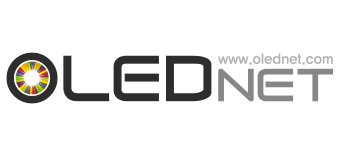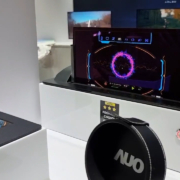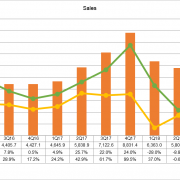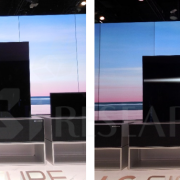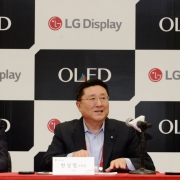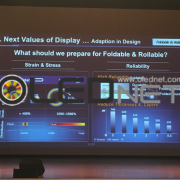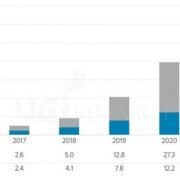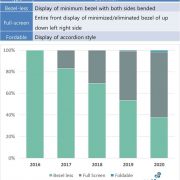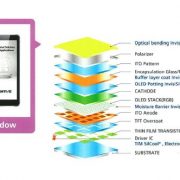Posts
[Press Release] AMOLED sales to reach USD 32.2 billion in 2019, up 13.8% from 2018
/in Display, Focus on, Market /by oledUBI Research (CEO, Yi, Choonghoon) published the annual OLED report in 2019.
According to the report, the OLED market is expected to reach $ 32.2 billion in 2019 and 13.8% market growth. The market growth is due to the launch of a variety of applications in 2019. Foldable OLED will accelerate the growth of the flexible OLED market as a convergence product that fuses smartphones and tablet PCs, and 8K OLEDs and rollable OLEDs to be launched from 2H 2019 will further solidly support the premium OLED TV market. In addition, an increase in flexible OLED shipments due to improved yields by Chinese panel makers will support growth in the Chinese OLED market.
AMOLED revenue in the fourth quarter of 2018 was $ 7.9 billion, down 3.7% from $ 8.2 billion in the third quarter and down 10.4% from $ 8.8 billion in the fourth quarter of 2017. The quarterly OLED market was highly volatile due to sales fluctuations at Samsung Display.
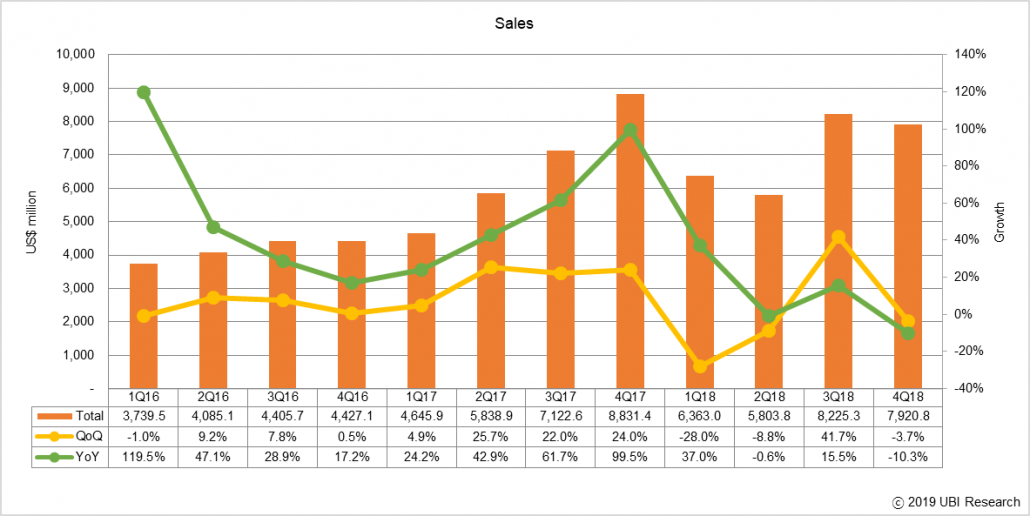
Revenue in 2018 was $ 28.3 billion, up 7.1% from $ 26.4 billion in 2017. The growth slowed suddenly compared to growth of 58.7% in 2017. The sluggish growth is attributable to the sluggish OLED smartphone market, which drove the OLED market up until now. The OLED market for smartphones, which was worth $ 24.2 billion in 2017, was only $ 24.5 billion in 2018.
Flexible OLED panels are not being adopted in mid-end smartphones due to the high cost of manufacturing flexible OLED panels for smartphones. As a result, the oversupply will continue due to lack of demand compared to the 6G flexible OLED investment. In the fourth quarter of 2018, there was an oversupply of 31%. In the first quarter of 2019, oversupply will increase to 39% by overlapping seasonal demand decline.

CES2019, the biggest issue of TV is LG Electronics OLED TV R
/in Exhibition, Focus on, Set /by olednetReporter : Daejeong Yoon
The CES, held in early January of each year, is the most important event to understand all of the consumer electronics trends of the year. This year, TV makers from all over the world exhibited a variety of products to attract spectators to the event.
When OLED TV occupied more than 50% of the premium TV market with more than $ 2,000, the LCD TV industry sought to prevent the OLED TV market from expanding by exhibiting 8K LCD TVs to CES. However, the attention and admiration of the spectators were poured into OLED TV R.
The 8K TV market began to open slightly from last year, in preparation for the 8K broadcast starting from the Tokyo Olympics in 2020. LCD TV companies displayed 8K LCD TVs of various sizes to preoccupy the market with the keyword of 8K. LCD TV, however, has not been recognized by viewers as a new TV product since Sharp has already exhibited steadily.
Another reason is OLED TV R displayed by LG Electronics. In the main body with built-in speaker, OLED TV rises up and goes down again. A lot of people came to see OLED TV R to shoot.
 <LG Electronics, OLED TV R>
<LG Electronics, OLED TV R>
Last year, micro LED TVs became more prominent. In addition to Samsung Electronics, Sony, TCL and Hisense exhibited micro LED TVs this year. It seems that the gap of micro LED TV technology between Korean companies and Chinese companies is only about one year. In the micro LED TV market based on assembly technology that does not require special manufacturing technology, China, which is the world’s best LED industry and infrastructure, is expected to dominate the market soon.
However, as LG Display has a unique OLED TV manufacturing technology, which has a very complicated panel structure and manufacturing process, the technological gap between Korea and China is expected to be more than five years difference. In this situation, OLED TV R, released by LG Electronics, once again realizes that Korea’s OLED technology is the best in the world.
On the other hand, TV companies’ display of OLED TVs, except for LG Electronics, has stagnated. These companies are not yet receiving 8K OLED panels and rollable OLED panels from LG Display. Even Sony does not have any special features, only OLED TVs that are well known so far.
As a result, the CES TV show was notable only for LG Electronics.
It is judged that LCD TV using mini LED that TCL has released can compete with OLED TV in this exhibition. The contrast ratio is displayed as 1,000,000: 1 similar to OLED TV. Black is a very good product that has a vibrant color and contrast ratio similar to OLED TV. However, a holo-effect was found around the bright screen displayed on the black desktop. It is a phenomenon that the surroundings appear to spread brightly. As it is invisible to non-specialists, it is competitive in price and is a product that can compete well with OLED TVs.

< TCL, 8K QLED TV with mini LED>
LG Display Vice Chairman Han Sang-Bum, “50% of sales of OLED and upbringing business in 2020”
/in Display, Exhibition, Focus on /by olednetGrowing into the mainstream of OLED growth by expanding large OLED, differentiated products and supply
■ Small and Medium-sized POLED, strengthening fundamental business capacity and preparing future products such as Foldable
■ Develop commercial and automotive products, new technologies / new markets and develop into first-class business
LG Display is one of the world’s largest electronics exhibitors, and will hold a press conference at the Las Vegas Convention Center (LVCC) in Las Vegas on June 7, the day before the opening of the Consumer Electronics Show (CES) with Han vice chairman, executive vice president Kang In-Byoung, Strategy and Marketing Group Director Song Young-kwon, and other executives.

At the meeting, Han Sang-bum said, “Although there were many difficulties due to excessive supply and enormous investment due to intensified global competition last year, large-sized OLED business turned to surplus and stable profit was generated mainly in high value-added products. “This year, LG Display will focus on OLED investments, accelerating OLED growth, and focus on commercial and automotive businesses. By 2020, LGD will account for more than 50% of total OLED and growth businesses. “He said.
To this end, LG Display plans to expand its large-size OLED market, strengthen its fundamental business capabilities in small- and mid-sized P-OLED (plastic OLED) businesses, and develop new markets with differentiated commercial and automotive products.
■ Large OLED, differentiated products and supply expansion
Since LG Display first supplied OLED TV panels in 2013, LG Display has continued to develop its technology. And last year, it sold nearly 3 million units and developed into a strong player in the premium TV market. This year, the company plans to expand its TV product lineup from the existing 4K resolution to 8K, and to further enhance its competitiveness by further enhancing performance such as luminance and response time. In addition, the company will expand its market by expanding differentiated products such as wall paper, CSO (Crystal Sound OLED), rollable and transparent display. LG Display will complete the G8.5 OLED panel factory in Guangzhou, China in the first half of this year, and mass-produce OLED from the third quarter. Through this, the company plans to expand its sales volume from 2.9 million units in 2018 to 4 million units this year, and to achieve more than 10 million units in 2021.
In addition, LGD will expand sales areas for existing customers, strengthen collaboration with strategic customers, and increase sales of premium products such as ultra-large size panel.
■ Small and mid-sized P-OLED, strengthening fundamental business capacity and preparing future products.
LG Display is targeting the small- and mid-sized OLED market through P-OLED.
This year, it is a great challenge to develop core technologies and products for strategic customers in a timely to raise market share of small- and medium-sized panel.
In addition, LGD plans to increase the production capacity of the Gen 6 Gumi factory, which has a capacity of 15,000 sheets per month, and to expand the P-OLED production capacity by early stabilizing the Gen 6 factory in Paju.
In addition, LGD plans to steadily prepare related technologies and infrastructure so that future products such as Foldable can be released on time.
■ Commercial and automotive displays, Fostering first-class business
LG Display nurtures the rapidly growing commercial and automotive businesses to first-class business.
In the commercial market, LGD plans to pursue differentiated products such as 98 and 86 inches, ultra-slim products such as in-touch, bezel of 0.44 mm, transparent and gaming.
For automobiles, LTPS-based high-resolution LCDs and P-OLEDs are expected to focus on 8-inch and larger screens and high-resolution products. In addition, LGD will prepare its production infrastructure to expand its business in a timely manner and further strengthen its cost competitiveness, thereby achieving the first place in the fast growing auto market.
This year LGD plans to complete investment in preparation for the future, which began in 2017. LGD Han Sang-Bum, vice chairman of LG Display, said, “LG Display will be able to lead the global display market once again with OLED.
[IMID 2018] Samsung Display, The key material that will connect the smart world and the individual in the future is the display
/in Focus on, Others /by Daejeong YOONReporter & Analyst : Daejeong Yoon
At IMID 2018 held in BEXCO, Busan, Korea on August 29, Kwak Jin-Oh, vice president of Samsung Display, delivered a keynote speech on the theme of ‘The Infinite Evolution with Display’. He emphasized “Display will be the key material to link to the smart world and the creation of a new world and environment will be accelerated.”
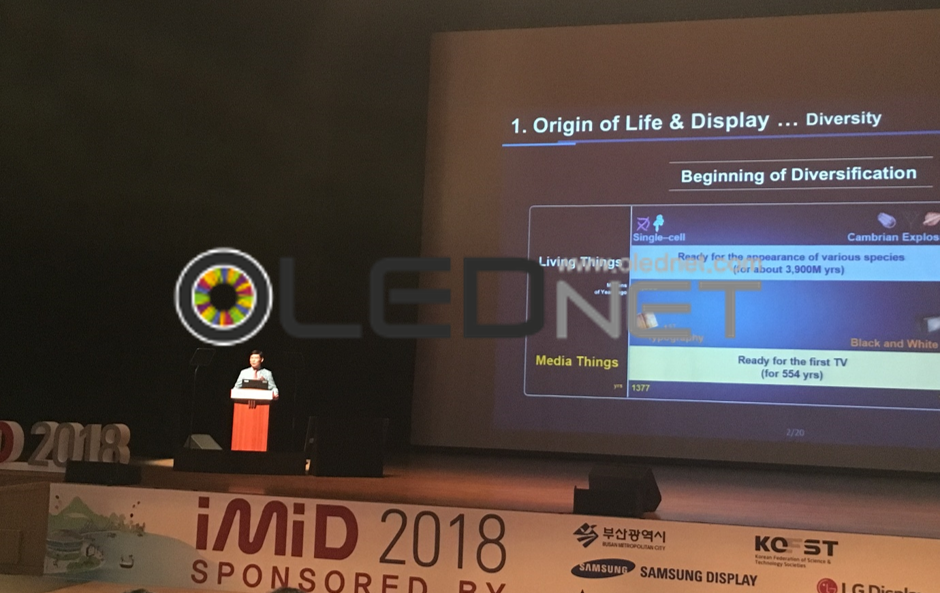
Comparing the evolution of living things with the evolution of displays, Kwak pointed out the direction of the next-generation displays such as ‘size diversity from small to large size, adaption in design inclusive of full screen and flexible, and convergence with other technologies’.
In terms of size diversity, Kwak said, “High-resolution displays that can feel realism in small and medium-sized area, and displays that can be immersed like a big screen in a movie theater in large area, are required.”
The design adaptation then was referred to design autonomy as one of the values of next-generation displays. He further emphasized the value of rollable and stretchable displays as well as foldable displays in small and medium sized displays.
Kwak said that Samsung is developing rollable displays as well as foldable displays that are currently attracting great interest. Unlike foldable display, rollable display requires consideration of the stress on the front of the panel. He commented “Because there are many things to consider such as the time when it is rolled up, and the number of times it is rolled and unrolled, the company is conducting research to solve them.”
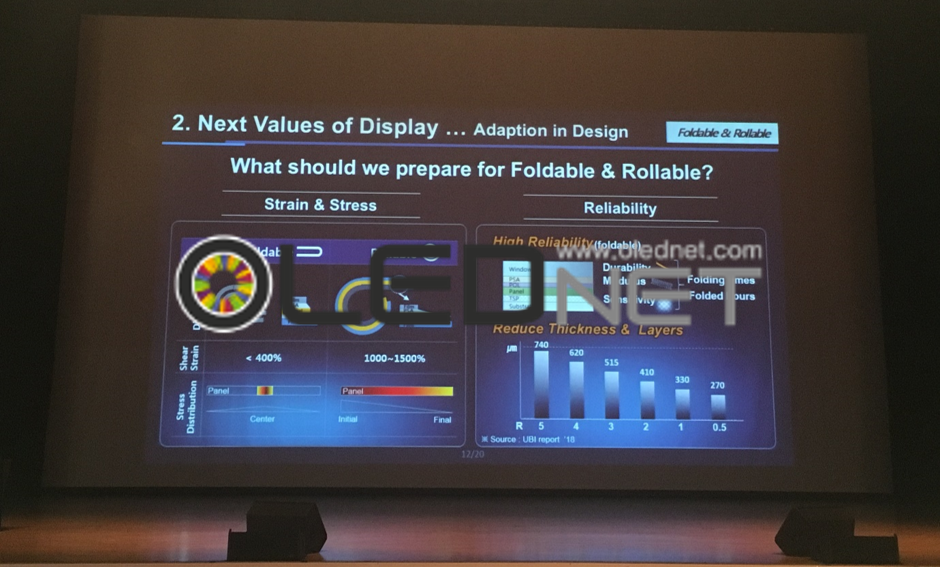
He also introduced a stretchable display that can implement patterns freely, and explained that it is developing various structures using RGB pixel unit and stretchable unit to implement displays that have high reliability with low stress.
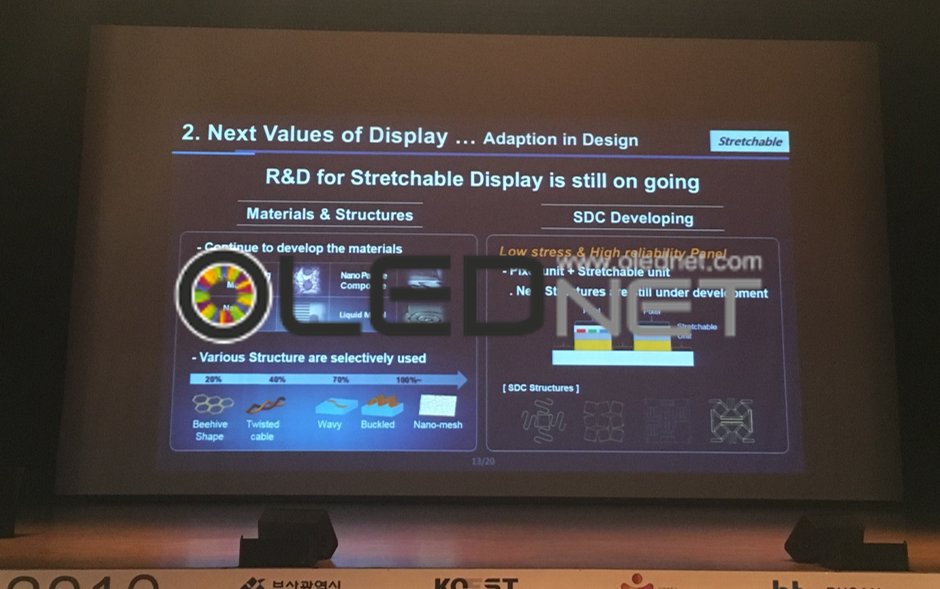
Mentioning about biotechnology at the convergence area, he pointed out that new fusion technologies need to be considered such as measurement of oxygen saturation by transmitting light to hemoglobin or changes in the wake up mode and sleep mode of the display depending on the melatonin change.
Finally, Kwak concluded that display is evolving to create a new society and environment, emphasizing that display is the key material to link between the individual and the smart world in the forthcoming 5G era.
OLED TV continuing to evolve
/in Exhibition, Set /by OLEDNETAt the ‘4th 2018 OLED Korea Conference’ hosted by UBI research on March 7-8, Dr. Han Chang-Wook, Chief Research Fellow of LG Display, made a presentation for the development process of OLED TVs and emphasized the image quality of OLED, design flexibility and expandability.

At first, Dr. Han introduced three core technologies including TFT technology, OLED stack technology, and compensation circuit design applied to OLED TVs. He said, “We changed the TFT as top gate coplanar structure for UHD implementation in bottom gate TFT applied to FHD.” He also mentioned “We changed the WRGB OLED pixel structure from 2 stack structure to 3 stack structure to improve the luminance and color reproduction ratio, and designed the compensation circuit so that it does not affect the OLED even on 8K large screen.”
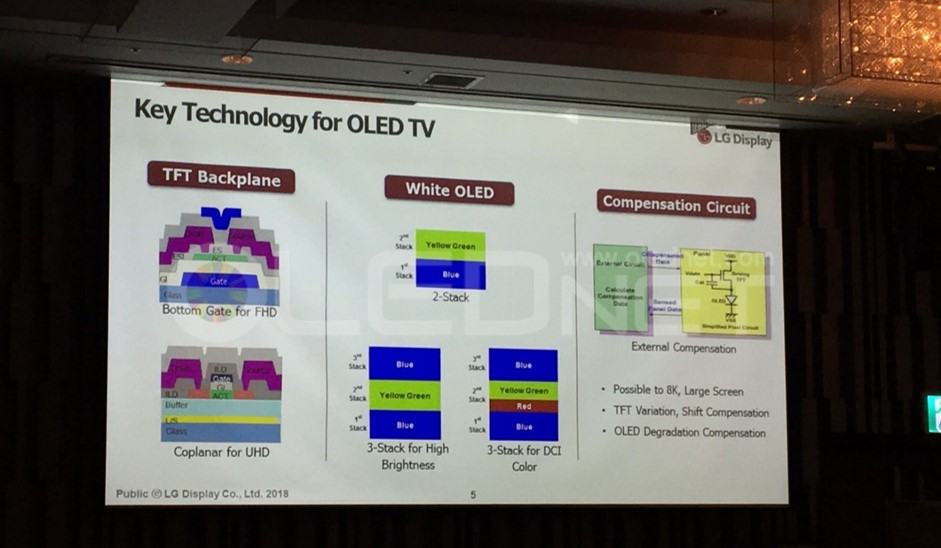
He commented, “Unlike LCDs that control pixels with local dimming, OLEDs have pixel dimming controls, which allows for full black representation and less halo effects”
Explaining that OLED allows greater design flexibility and expandability because of the self-illuminating properties that does not require backlight, he referred to the mirror display and transparent display applicable to indoors, and the world’s first 88 inch 8K OLED TV and 65 inch rollable OLED TV exhibited at CES 2018.
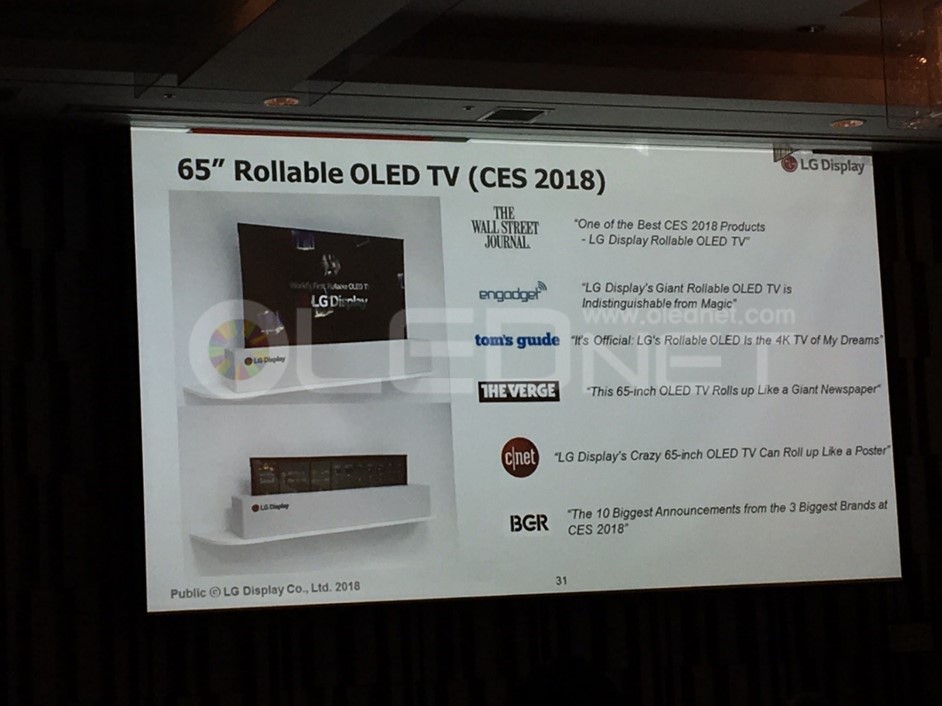
Dr. Han said “We expect large OLED panel production to be tripled, compared to 2016, with the expansion of production lines and yield improvement in 2018. In addition, the company will be able to ship over 6 million large area OLED panels by 2020 through the expansion of its Paju and Guangzhou plants.” He also announced that the company will increase continuously the production for OLED panels, which were 5% of the total display panels in 2016, by 40% by 2020.
진화를 거듭하고 있는 OLED TV
/in 미분류 /by OLEDNET3월 7일 유비리서치가 주최한 ‘2018 OLED 코리아 컨퍼런스’에서 LG Display의 한창욱 수석연구위원은 OLED TV의 발전 과정을 소개하며 OLED의 화질(image quality)과 디자인 유연성(design flexibility), 확장성(expandability)을 강조하였다.

먼저 한 수석연구원은 OLED TV에 적용 된 TFT 기술과 OLED stack 기술, 보상회로 설계 등 3가지 핵심 기술들을 소개하였다. 한 수석연구원은 “FHD에 적용 된 bottom gate TFT에서 UHD 구현을 위해 top gate coplanar 구조로 TFT를 변경하였다”고 설명하였으며, “휘도와 색재현율 향상을 위해 2 stack 구조에서 3 stack 구조로 WRGB OLED 화소 구조를 변경하였으며 8K 대형 화면에서도 OLED에 영향이 없도록 보상 회로를 설계하였다”고 밝혔다.

이어서 한 수석연구원은 OLED의 최대 장점으로 “local dimming으로 화소를 제어하는 LCD와 다르게 OLED는 pixel dimming으로 화소를 제어하기 때문에 완벽한 블랙 표현이 가능하고 윤곽선 주변이 빛나보이는 halo effect가 적다”고 강조했다.
또한, OLED는 back light가 필요 없는 자발광 디스플레이기 때문에 디자인 구현과 확장성이 가능하다고 설명했다. 그 예로 실내에서 적용 가능 한 mirror display와 transparent display를 언급했으며 CES 2018에서 선보인 세계 최초의 88 inch 8K OLED TV와 65 inch rollable OLED TV를 언급하였다.

한편, 한창욱 수석연구원은 “2018년에는 생산라인 확대와 수율 개선을 통해 대형 OLED 패널 생산량이 2016년보다 3배 수준으로 늘어날 것으로 예상된다. 또한 파주와 광저우 공장 증설을 통해 2020년에는 600만장 이상의 대형 OLED 패널 출하가 가능할 것”이라 밝혔다. 또한, 2016년 전체 디스플레이의 5% 수준이었던 OLED 패널 생산량을 2020년까지 40% 이상 끌어올리겠다고 밝혔다.
가상(VR)·증강현실(AR)이 선택한 ‘OLED 디스플레이’
/in 미분류 /by OLEDNET최근 4차 산업혁명을 주도하고 있는 가상·증강현실 기기에 OLED 디스플레이를 채용함으로써, LCD에 비해 응답속도가 빠르고 풍부한 색감과 높은 명암비 구현이 가능해짐에 따라, 사용자는 보다 현실감 있고 생동감 넘치는 영상을 체험할 수 있게 되었다.
가상·증강현실용 OLED 디스플레이는 게임, 광고, 교육 등 전 산업 분야에 걸쳐 폭넓게 활용되고 있으며, 이에 따라 관련 출원이 최근 활발하게 이루어지고 있는 것으로 나타났다.
특허청에 따르면, 가상·증강현실용 OLED 디스플레이의 출원은 매년 증가 추세에 있으며, 특히 최근 3년간 관련 출원이 크게 증가한 것으로 나타났다.
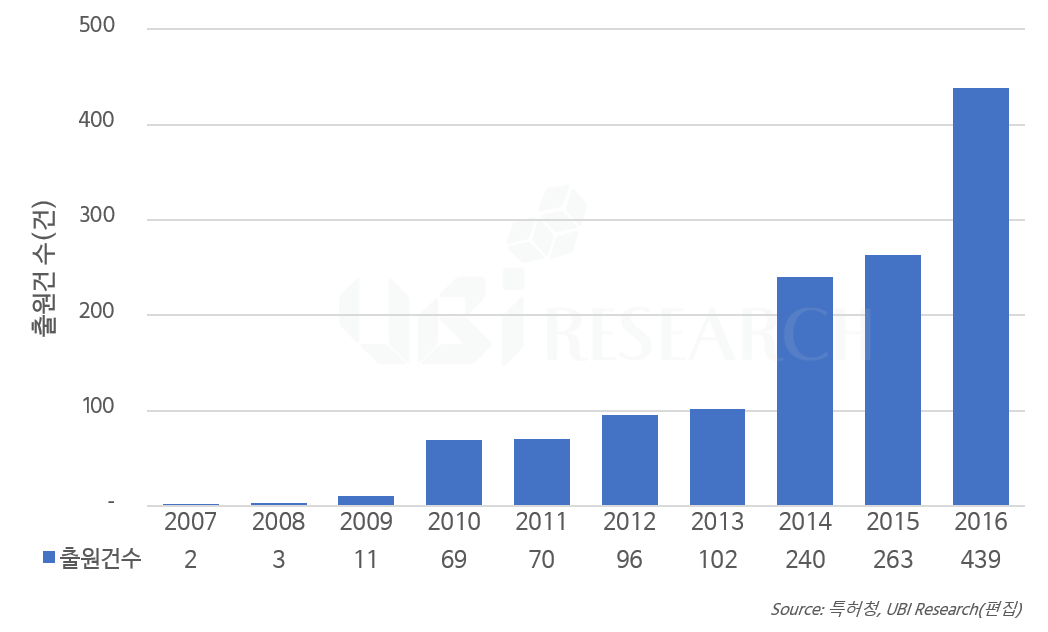
<가상·증강현실용 OLED 디스플레이 출원 동향, 출처: 특허청>
최근 연도별 출원 현황을 보면, 2014년 240건, 2015년 263건, 2016년 439건으로, 2014년을 기점으로 가상·증강현실용 OLED 디스플레이 기술에 관한 출원 건은 급격히 증가하였다.
가상·증강현실용 OLED 디스플레이 분야 출원이 최근에 증가한 이유는 가상·증강현실 기기의 본격적인 대중화를 위한 선결 과제로 해상도와 응답속도, 활용성, 착용감, 가격 등 다양한 조건들의 발전이 요구되고 있는데, OLED 디스플레이는 실감나는 영상을 구현할 수 있고, 플렉시블 설계가 용이하다는 점에서 기존의 LCD에 비해 이러한 니즈를 월등하게 충족할 수 있기 때문인 것으로 보인다.
또한, 2020년 기준으로 가상·증강현실 시장 규모가 약 800억 달러로 크게 증가될 것이라는 전망에 비추어 볼 때, 가상·증강현실 기기에 적합한 OLED 디스플레이가 플렉시블, 롤러블, 벤더블 및 스트레쳐블 디스플레이 형태로 다양하게 개발됨에 따라 가상·증강현실용 OLED 디스플레이 기술에 관한 출원의 증가 추세는 지속될 것으로 예상된다.
가상·증강현실용 OLED 디스플레이 기술에 관한 출원인별 출원 현황(2007년 ~ 2016년)은 대기업 774건(60%), 중견·중소기업 142건(11%), 대학‧연구기관 72건(6%), 개인 70건(5%)을 출원하였고, 외국인이 237건(18%)을 출원한 것으로 조사되었다.
주요 출원 업체별로는 엘지전자 465건, 삼성전자 216건, 마이크로소프트사 51건, 삼성디스플레이 29건, 에스케이플래닛 20건, 퀄컴 17건, 엘지디스플레이 17건 순으로 집계되어, 가상·증강현실용 OLED 디스플레이 관련 기술이 국내 기업에 의해 주도되고 있음을 알 수 있다.
가상·증강현실용 OLED 디스플레이의 응용분야별 출원 현황을 보면 개인용 엔터테인먼트(게임, 테마파크, 체험관) 426건, 국방(전쟁 시뮬레이션, 무기개발, 전투기 조종) 169건, 광고 141건, 의료(3차원 시뮬레이션, 가상 내시경, 모의수술) 131건, 헬스케어 123건, 영화 117건 등으로 나타나, 가상·증강현실용 OLED 디스플레이 기술은 게임과 국방 산업 분야에 가장 활발히 활용되고 있음을 알 수 있다.
특허청 김종찬 디스플레이기기심사팀장은 “TV나 휴대폰과 같은 개인용 제품 중심으로 발달한 OLED 디스플레이는 뛰어난 영상제공 능력을 기반으로 가상·증강현실 뿐만 아니라 새로운 산업분야로 활용 영역의 확장이 예상되며, 아울러 OLED 디스플레이의 수명 연장 및 사용 온도 범위 확대 등 성능 향상 과제를 해결하기 위한 기술과 관련된 출원이 증가할 것으로 예상된다.”고 전망했다.
특허청은 OLED 디스플레이 분야의 특허경쟁력 강화를 위하여, 산업계와 특허청 간의 소통과 협력의 일환으로『IP Together』행사를 정기적으로 개최해 왔으며, ‘개정 특허법 설명회’ 등을 통해 관련 정보를 지속적으로 제공해 나갈 계획이다.
한편, 유비리서치가 발간한 ‘AR과 VR용 디스플레이 시장 보고서’에 따르면 AR과 VR용 OLED는 2017년 260만개 출하되어 52%의 시장 점유율을 차지할 것으로 예상하였으며, 2021년에는 5,200만개 출하되어 80%의 시장 점유율을 차지할 것으로 전망하였다.
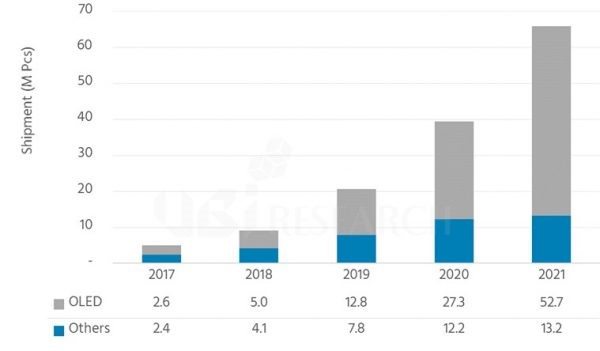
<AR과 VR용 디스플레이 타입별 출하량 전망, 출처: 유비리서치>
‘OLED display’ selected by virtual (VR) · Augmented Reality (AR)
/in 미분류 /by OLEDNETBy adopting OLED display in virtual and augmented reality devices, which are leading the fourth industrial revolution in recent years, users can experience more realistic and lively images with faster response time, richer color and higher contrast ratio comparing to LCD.
OLED displays for virtual and augmented reality have been widely used in all industries including games, advertising, and education, and related applications have recently been actively pursued.
According to the Korean Intellectual Property Office (KIPO), the filing of OLED display for virtual and augmented reality is on an increasing trend each year, in particular, the number of related applications has greatly increased over the last 3 years.
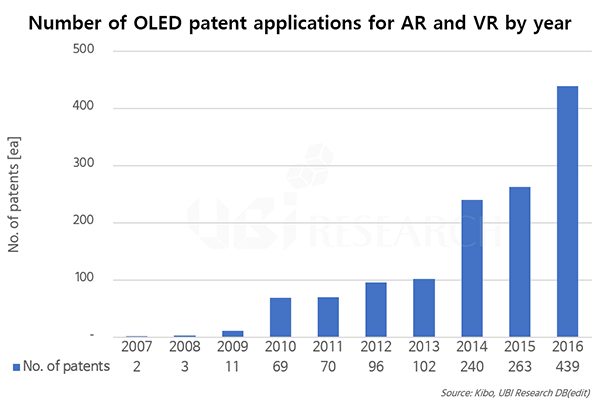
<OLED display application trend for virtual and augmented reality, Source: Korean Intellectual Property Office>
According to the recent filing status by year, there are 240 applications in 2014, 263 in 2015, and 439 in 2016, and applications for OLED display technologies for virtual and augmented reality have increased rapidly from 2014.
The reason for the recent increase in applications for virtual and augmented reality OLED display fields is that the development of various conditions such as resolution, response time, usability, comfort, and price is required as a preliminary task for popularization of virtual and augmented reality devices and OLED displays can realize realistic images and are easy to design with flexibility, which is why they can meet these needs much better than existing LCDs.
Also, given the prospect that the virtual and augmented reality market will increase to about $ 80 billion by 2020, OLED displays suitable for virtual and augmented reality devices are being developed in various forms such as flexible, rollable, bendable, and stretchable displays, and it is expected that applications for OLED display technology for virtual and augmented reality will continue to increase accordingly.
For the filing status of OLED display technology for virtual and augmented reality (2007 ~ 2016), there are 774 cases (60%) of large companies, 142 cases (11%) of medium and small-sized companies, 72 cases (6%) of universities and research institutes, 70 individual cases (5%) 237 foreigner cases (18%).
By major application companies, 465 cases of LG Electronics, 216 cases of Samsung Electronics, 51 cases of Microsoft Corporation, 29 cases of Samsung Display, 20 cases of SK Planet, 17 cases of Qualcomm, 17 cases of LG Display, It can be seen that related technology is dominated by domestic companies.
As for the status of OLED display application field for virtual and augmented reality applications, there are 426 cases of personal entertainment (game, theme park, experience), 169 cases of defense (war simulation, weapons development, fighter pilot), 141 cases of advertisement, 131 cases of medical treatment (3D simulation, virtual endoscopy, simulation), 123 cases of healthcare, 117 movies, etc., indicating that OLED display technologies for virtual and augmented reality are most actively used in the game and defense industries.
“OLED displays, which are developed mainly for personal use products such as TVs and mobile phones, are expected to expand into new industries as well as virtual and augmented reality based on their superior image presentation capabilities,” said Kim Jong-Chan, head of the screening team in the Korean Intellectual Property Office (KIPO). In addition, we expect to see increased applications related to technologies to address performance improvement challenges, such as extending the life of OLED displays and extending the operating temperature range. “.
In order to strengthen the patent competitiveness of OLED display field, KIPO has regularly held “IP Together” event as part of communication and cooperation between industry and patent office, and will continue to provide related information through the “Revised Patent Law Seminar”.
On the other hand, according to the ‘Display Market Report for AR and VR’ published by UBi Research, OLED for AR and VR are expected to be shipped by 2.6 million units in 2017, accounting for 52% of the market share and 52 million units in 2021 accounting for 80% of the market share.
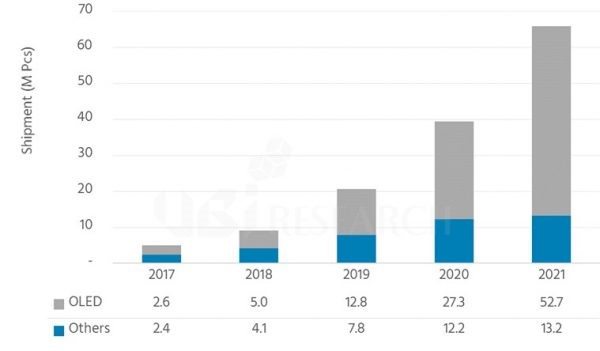
<Shipment forecast by display type for AR and VR, Source: UBI Research>
스트레처블(stretchable) OLED 상용화 앞당겨진다.
/in 미분류 /by OLEDNET삼성전자와 LG전자는 2013년부터 플렉시블(flexible) OLED를 적용한 스마트폰과 스마트워치를 꾸준히 출시하고 있으며, 중국의 가전업체에서도 이를 적용한 제품들을 하나 둘 내놓기 시작했다. 특히 스마트폰 업계의 선두 주자인 Apple도 플렉시블 OLED를 적용한 iPhone 출시를 눈앞에 두고 있어 플렉시블 OLED 시장은 더욱 커질 전망이다.
플렉시블 OLED의 형태는 향후 벤더블(bendable)을 지나 폴더블(foldable), 롤러블(rollable)로 변화될 것으로 예상되었다. 그러나 최근 디스플레이 업계가 이를 뛰어넘고 스트레처블(stretchable) OLED 개발에 나서고 있어 소비자의 관심이 집중되고 있다.
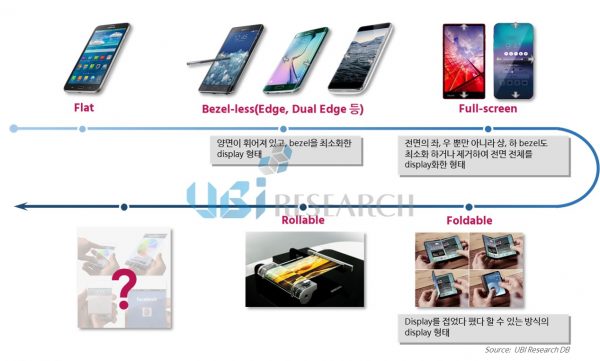
<OLED 개발 로드맵, 출처: 유비리서치>
스트레처블 OLED는 플렉시블 OLED가 최종적으로 진화한 형태로서 고무줄처럼 신축성을 가지는 OLED를 의미한다.
삼성디스플레이는 이러한 스트레처블 OLED를 SID 2017에서 공개하였다. 삼성디스플레이의 스트레처블 OLED는 9.1 inch로 convex와 concave 형태 모두 구현이 가능하다. 당시 삼성디스플레이는 concave 형태에서 최대 12 mm로 화면이 늘어나면서도 기존의 화질은 그대로 유지하는 기술을 세계 최초로 구현했다고 밝힌 바 있다.

<삼성디스플레이가 전시한 9.1 inch stretchable OLED, 출처: 삼성디스플레이>
LG디스플레이도 스트레처블 OLED를 개발할 예정이다. LG디스플레이는 지난 6일고려대와의 컨소시엄을 통해 20% 이상 신축성을 갖는 백플레인과 발광 화소용 소재, 소자, 공정 원천기술을 총 4년동안 개발할 예정이라 발표하였다.
뿐만 아니라 LG디스플레이는 신축성 플라스틱 기판 소재, 신축성 배선금속과 투명전극 소재, 신축성 유기발광 소재, 신축성 봉지 소재 등을 개발하고, 저온 공정이 가능한 TFT(thin film transistor)와 공정 구조(process architecture) 등을 포함하는 필수 공정기술도 함께 확보할 예정이라 덧붙였다.
현재 스트레처블 관련 기술은 아직 양산에 적용하기 어렵거나 연신율이 5% 남짓에 불과하고 반복 스트레칭 횟수도 제한되어 있다. 또한, 원천 기술은 대부분 해외에 있어 삼성디스플레이와 LG디스플레이의 이러한 행보는 후발주자와의 기술격차를 확고히 다지는 계기가 될 것으로 예상된다.
스트레처블 OLED는 형태의 제약이 없어 상용화 될 시 기존의 스마트폰이나 태블릿 의류, 인간의 피부 등 다양한 분야에 적용되어 기존과는 새로운 영역의 application을 창출해 낼 것으로 기대되고 있다.
Stretchable OLED commercialization is on the rise
/in Market, Set, Technology /by OLEDNETSamsung Electronics and LG Electronics have steadily been releasing smartphones and smart watches using flexible OLED since 2013, and electronics companies in China have begun to put out one of them. In particular, Apple, the leader in the smartphone industry, is also seeing the launch of iPhone with flexible OLED, and the flexible OLED market is expected to grow further.
The shape of the flexible OLED was expected to be changed to foldable and rollable beyond the bendable. Recently, however, the display industry has surpassed this trend and has been focusing on the development of stretchable OLEDs.
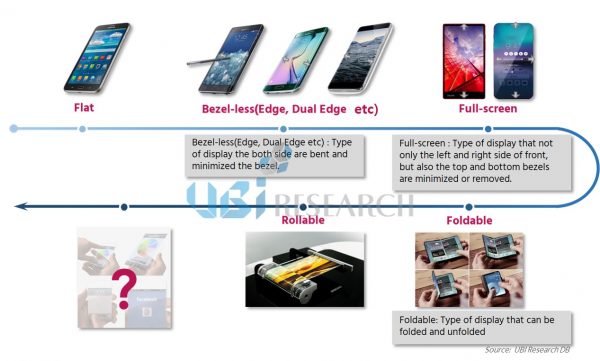
<Development Roadmap of OLED, Source: Ubi Research>
A stretchable OLED is a type of a flexible OLED that is finally evolves, which means OLED having elasticity as like rubber band.
Samsung Display unveiled this stretchable OLED at SID 2017. Samsung Display’s stretchable OLED is 9.1 inch and implementable both convex and concave shapes. At the time, Samsung Display announced that it realized the world’s first technology to maintain the existing image quality while increasing the screen size to 12 mm in concave mode.

<9.1 inch stretchable OLED displayed by Samsung Display, Source: Samsung Display>
LG Display will also develop the stretchable OLED. LG Display announced on June 6 that it will develop backplane and photoluminescence materials, devices, and process source technologies with elasticity of more than 20% for a total of four years through a consortium with Korea University.
In addition, LG Display has developed flexible plastic substrate materials, flexible wiring materials and transparent electrode materials, stretchable organic light emitting materials, and flexible encapsulates, they will also acquire essential process technologies including thin film transistors (TFTs) and process architectures that enable low-temperature processing.
At present, stretchable related technology is not yet applied to production, or elongation is only about 5%, and the number of repeated stretching is limited. In addition, most of the source technology is in overseas, it is expected that Samsung Display and LG Display will be able to secure technological gap with latecomers.
Stretchable OLED is free of form restrictions and expected to produce applications in new areas when applied to a variety of applications such as smart phones, tablets clothes and human skin when they are commercialized.
Next to Bezel-less is full-screen, Prospect of 60% market share of full-screen OLED panel in 2020.
/in Focus on, Market /by OLEDNETSmartphone displays have been diversifying as the hard wares and soft wares in smartphone have been improving. Samsung edge series have successfully entered the flexible OLED smartphone market and other smartphone companies now are manufacturing flexible OLED based products. Furthermore we are expecting a big change in the display market as Apple may release its new iPhone models with OLED in 2017.
According to a recent study “Key Issue and The Market Analysis for Foldable OLED” from UBI research, it is expected that bezel-less type of flexible OLED, which is an upgraded model of dual edge display, will lead the market until 2017 and then there will be new smartphones with various forms of displays as new types of flexible OLED like full-screen, foldable, rollable displays will be launched after.
Also, they expected that full screen displays will be invented by reducing the size of the top and bottom bezels as well as sides bezels and they will be leading the market afterwards.
Moreover, according to the report, they analyzed that the full-screen OLED panels will be at around 17% market share of total flexible AMOLED panel market in 2017 and it will reach around 60% while it will surpass the market share of bezel-less typed panels.

Definition of each Flexible OLED type and the prospect of a market share (UBI Industrial Research)
Researchers also expected that there will be a strong chance that they will release new smartphones with foldable display in 2017 to see how the market reacts and they will get seriously start to manufacture mass production from 2019, taking consumers needs into consideration and anticipating the direction of technology and pace of change. In addition, the size of foldable smartphone’s market is expected to take up to 2% market share by 2020 as around 1.5 million foldable smartphones will be expected to be manufactured.
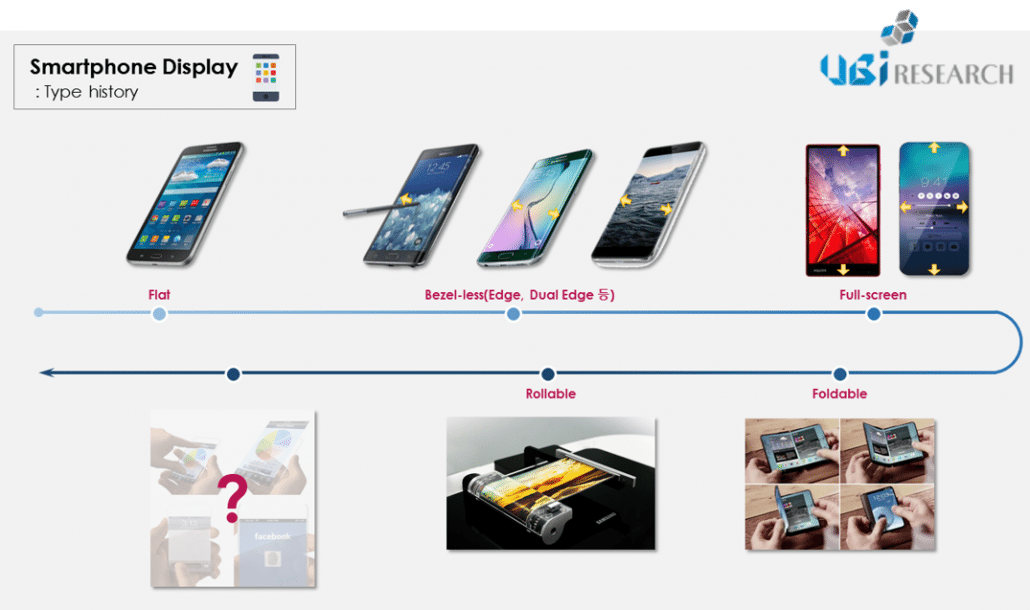
History of each Smartphone display types. (UBI Industrial Research)
Bezel-less 다음은 full-screen, full-screen OLED panel 2020년 60% 시장 점유 전망
/in 미분류 /by OLEDNET스마트폰의 성능, 디자인 등이 진화함에 따라 스마트폰용 디스플레이의 형태도 다양화되고 있다. 삼성전자의 edge 시리즈가 flexible OLED 스마트폰 시장에 성공적으로 진입하였고, 다른 업체들도 flexible OLED 기반의 제품을 적용하고 있다. 특히 2017년에는 애플의 아이폰에 OLED가 탑재될 것으로 예상되어 디스플레이 시장에 큰 변화를 가져올 것으로 기대하고 있다.
시장조사업체 유비산업리서치가 최근 발간한 ‘Key issue and Market Analysis for Foldable OLED’에 따르면 2017년까지는 dual edge 타입에서 변형된 bezel-less 타입의 flexible OLED가 스마트폰 시장을 주도하고, full-screen, foldable, rollable 등 새로운 타입의 flexible OLED가 등장하여 다양한 형태의 디스플레이가 탑재된 스마트폰이 등장할 것으로 전망했다.
특히 좌, 우 뿐만 아니라 상, 하 bezel도 최소화 하거나 제거하여 전면 전체를 display화 한 형태의 full screen display가 2017년부터 등장하여 이후의 시장을 주도할 것으로 내다봤다.
보고서에서는 full-screen OLED panel이 전체 flexible AMOLED panel 시장 중 2017년 약 17%의 점유율에서 2020년에는 약 60%로 bezel-less type의 OLED panel 점유율을 넘어설 것으로 분석했다.

Flexible OLED type별 정의와 시장 점유율 전망 (출처: 유비산업리서치)
Flexible OLED 스마트폰 중 가장 큰 이슈인 foldable 스마트폰에 대해서는 시장의 반응을 살펴보기 위해 2017년에 첫 선을 보일 가능성이 높을 것으로 전망했으며, 소비자들의 니즈와 기술개발 동향을 분석해 봤을 때 2019년부터 본격적인 양산이 시작이 가능할 것으로 전망했다. 또한 Foldable 스마트폰 시장 규모는 2020년에 약 1,500만대가 출하되어 전체 flexible OLED panel 시장의 2%의 점유율을 이룰 것으로 예상했다.

스마트폰 디스플레이의 type별 히스토리 (출처: 유비산업리서치)
Silicone Better than Acrylic for Flexible OLED…Momentive Introduces InvisiSil
/in 미분류 /by OLEDNET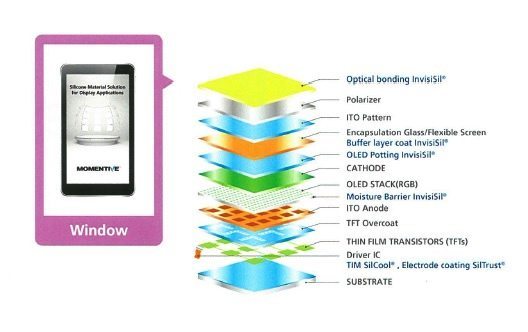
Momentive demonstrated InvisiSil at SID 2016 (Source = Momentive)
Hyunjoo Kang / jjoo@olednet.com
One of the issues of flexible OLED actualization is acrylic’s vulnerability against lower temperature, and silicone is emerging as a solution. Meanwhile, Momentive is attracting attention with their promotion of silicone based InvisiSil.
One of the key encapsulation technologies for flexible OLED is TFE (thin film encapsulation) that laminates thin inorganic and organic films, used by Samsung Display. Of these, organic material is formed through inkjet OLED process using acrylic materials. However, acrylic organic materials are easily broken under 0 ℃, which leads to difficulties in producing flexible OLED using these. However, silicone based materials can withstand up to -40 ℃ and are considered strong candidate for acrylic replacement.
Momentive is a company that develops such silicone based materials. In SID 2016 (22-27 May), Momentive opened an exhibition booth and presented InvisiSil Snap Cure silicones. The InvisiSil Snap Cure systems can cure rapidly at room temperature without UV exposure.
Momentive explained that for flexible AMOLED panel to move past edge type and toward true flexible such as foldable and rollable, silicone is much better suited than acrylic. Furthermore, they added that silicone based materials have yet revealed any disadvantages compared to acrylic, and that it is in development for continued application to mass production.
플렉서블 OLED, 아크릴보다 ‘실리콘’이 제격…모멘티브, InvisiSil 선보여
/in 미분류 /by OLEDNET
모멘티브는 SID 2016 에서 전시부스를 운영하며 InvisiSil 을 시연했다. (출처=모멘티브)
강현주 / jjoo@olednet.com
플렉서블 OLED 를 구현하는 데 있어서 아크릴이 낮은 온도에 취약하다는 게 해결과제가 되고 있다. 대체 물질로 ‘ 실리콘 ’이 떠오르는 가운데 모멘티브가 실리콘 기반 물질인 InvisiSil 을 내세우고 있어 주목된다.
플렉서블 OLED 구현을 위한 대표적인 인캡슐레이션 기술로는 얇은 무기막과 유기막을 번갈아 쌓는 방식의 ‘ TFE (Thin Film Encapsulation) ’ 가 있으며 이는 삼성디스플레이가 사용하는 기술이다.
TFE 는 무기물과 유기물을 적층하는 방식으로, 이중 유기물은 아크릴계열의 물질이 잉크젯 OLED 공정으로 형성되고 있다.
하지만 아크릴 계열의 유기물은 0℃ 이하에서는 쉽게 깨진다. 이 때문에 아크릴은 플렉서블 OLED 를 구현하는 데 어려움이 있다.
반면 실리콘 계열 물질은 영하 40℃까지 견딜 수 있어 아크릴을 대체할 수 있는 유력한 재료로 평가받고 있다.
이 같은 실리콘 계열 재료를 개발하는 회사인 모멘티브는 지난 5월 22일부터 27일까지 샌프란시스코에서 열린 ‘ SID 2016 ’에서 전시부스를 열고 ‘ InvisiSil Snap Cure 실리콘 ’ 을 선보였다.
이 제품은 유기물질 경화 (curing) 시 자외선 ( UV ) 노출 과정을 생략할 수 있다는 점 등의 장점을 가지고 있다.
모멘티브 관계자는 “플렉서블 AMOLED 패널이 edge 타입을 넘어서서 폴더블과 롤러블 등의 진정한 플렉서블로 가기 위해서는 아크릴 보다 실리콘이 훨씬 더 유리하다. 현재까지 아크릴 대비 단점은 보이지 않고 있으며, 지속적으로 양산에 적용될 수 있도록 개발중이다”라고 설명했다.
